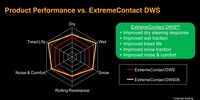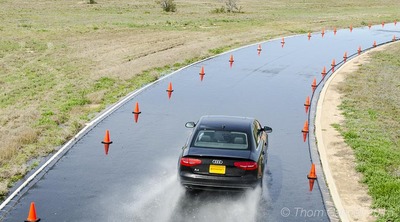The Auto Channel Tests Continental ExtremeContact DWS06
Hot Laps, Wet ABS, Wet Braking — Continental’s 2015 ExtremeContact DWS06
By Thom Cannell
Senior Editor
Michigan Bureau
The Auto Channel
Auto Central March 31, 2015; What’s in a tire’s name,
what does it tell a customer looking for replacement tires?
Continental’s ExtremeContact DWS ultra high performance tire launched
in 2009, the DWS means Dry, Wet, and Snow capability. Now, in 2015, a tire
that was already well regarded in the high performance arena gets
improvements, and improvements without significant compromises. It’s
now the ExtremeContact DWS06.
The Auto Channel visited Continental’s test facility in
Uvalde, Texas, to put this tire through almost every test you’d want
to know about, wet and dry braking, wet and dry handling, and how the tires
feel. However, there was no snow in Texas, which wasn’t much of a
surprise.
We first talked tire basics with Robert Liu, performance tire
product manager, so if you’re only interested in test
results—both objective and subjective, skip ahead.

|
The new tires are highly modified versions of the predecessor. Improvements
include traction-aiding microblocks which aid in cornering. The blocks
themselves are chamfered and this angled edge is surprisingly effective in
adding cornering grip. Silica, added for tread flexibility, is better
bonded with plio-silane (silane is an inorganic gas, SiH4 that acts as a
coupling agent). Blocks themselves are X-siped to increase biting edges as
the contact patch rolls forward. Continental uses molded-in indicators to
alert customers to wear and alignment. At the outer tread, alignment
indicators will rapidly show if tire alignment is off by wearing unevenly,
Also molded into the tire are letters D, W, and S. Once the S disappears,
the tire is no longer rated for light snow. W missing? Don’t expect
as good wet weather handling. When the D disappears it is time for new
tires, or dedicating them to the track, drifting, or auto-crossing. Sizes
vary from 16 up to 22” and are available in 51 sizes initially, with
more sizes available in September.
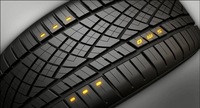
|
The ExtremeContact DWS06 is, depending on attribute (wet, dry, braking,
etc.), 1-10% better than its predecessor. We assure you, the changes can be
felt. Areas of emphasis for the new tire include insuring the tire fits
well into the wheel’s bead seat, fitting the toe to the rim; new
tread compounding; new tread designs. Also, all DWS06 use two plys to
create better impact resistance, especially resistance to potholes.
Tread compounds are composed, according to Dr. Peter Zmolek, director of
R&D for Continental Americas, of many substances, each offering scientists
and engineers “many knobs to tweak”. We learned that silica is
added to tire compounds mainly to accommodate ABS brakes! When ABS was
introduced and using pure carbon black, tires had a tendency to stick and
slide. Silica allows tires to brake effectively without sticking. Braking
is a combination of the tire and vehicle and thus ABS braking can be
optimized.
Carbon black itself has changed radically in the last decade. The
companies who make and supply “soot” are able to select and
affect particle size and surfaces adjusting to manage how the carbon black
bonds to other chemicals. “The more you investigate, the more you can
modify how it interacts,” Peter told The Auto Channel. Along with
carbon black and silica, tires contain natural rubber, artificial rubber
and other polymers (long chain molecules that knit together), accelerators
to aid in vulcanization of the tires (tires have to be heated and cured to
join all the components), fillers, and even canola oil to aid in mixing.
The whole package is termed “SPORT PLUS+ TECHNOLOGY.”
What many buyers will consider before performance is answered by
Continental’s “Total Confidence Plan” of a 50,000 limited
mileage warranty, 60 day or first 2/32 of treadwear satisfaction trial, 3
year flat tire roadside assistance, 12 month road hazard (or 2/32
treadwear), and 72 month limited warranty.
After learning about how the ExtremeContact DWS06 differs from the
older ExtremeContact DWS tire introduced in 2009 we bussed an hour south
of San Antonio, TX, to Uvalde,TX, home of Continental’s test track.
For our group, the first tire testing was on a wet road coarse driving 2015
Audi A4s and 2015 Ford Escapes. Therein lies a difference, four wheel drive
versus front wheel drive and a light sedan versus a heavier CUV. We drove
the Audi twice, first with the Continental tire, second with a very good
Bridgestone Potenza RE970 A/S Pole Position (we know it’s good,
it’s what’s on the author’s Audi allroad). The DWS06
delivered substantially more lateral traction, less understeer, and more
ABS brake grip. Overall it felt more confident and we were speedier, with
better steering and turn-in on both large and tight sweeping corners.
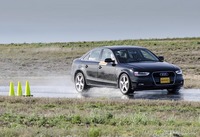
|
Next up, an Escape with ExtremeContact DWS06 versus Pirelli Scorpion Verde
AS. Our notes day “the Scorpion Verde slides like on ice compared to
the DW06, on open corners we slid through these “on ramps”
which does not inspire confidence (though it’s fun). Less stopping
power, no where near the grip on this wet track. With the DWS06 we had grip
everywhere, though the nose-heavy CUV wanted to massively understeer. The
Continental tire responded to steering input up to the limit, we had more
steering feel and response, and braking was shorter and more controlled.
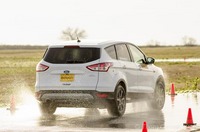
|
As much fun as that was, we shifted to an enormous 15 acre skid pad covered
with water. How much water? There were ripples on the surface! There we
tested old versus new DWS tires mounted on 2015 BMW M235is, and compared
the new DWS06 to Yokohama ADVAN Sport AS, another tire we’ve tested
recently, when mounted on Ford Mustangs. With the BMWs we could easily feel
the improvements delivered by the chamfered tread blocks they provided
superior grip overall. That said, the old tire was darn good, particularly
in intense maneuvering (though the 06 was better).
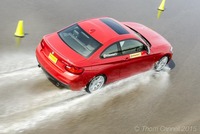
|
After the BMWs, it was Mustang time.Compared to the BMW, the hood was a
pilot’s view of a runway; it was endless. With Mustang’s RWD
bias we expected far more drama in acceleration and turns than we got.
Sure, we could have twisted the throttle and gotten slide-ways on the wet
asphalt, but our mandate was to keep things as close to the threshold as
possible to deliver accurate comparisons. Against the DWS06, the Yokohama
tire had less lateral grip and offered less steering feel. Though we had
less confidence, it is in no way a huge step down; the ADAVA remains a good
tire.
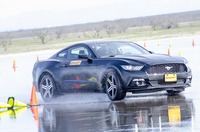
|
Our next event, full ABS stops with a G-meter to read deceleration and
stopping distance. We transited to the Uvalde wet grip course, a
5,100’ wet asphalt “pan”. Normally vehicles are coupled
to a guide rail to insure repeatable tests. We did not, so you’ll see
some variance in our tests—just as in the real world. Our first test
was another 2015 Mustang, equipped with Goodyear Eagle F1 Asymmetrical AS
tires. Stopping distance recorded as 100.8’ pulling 0.8G average,
0.9G peak. With another Mustang, equipped with the ExtremeContact DWS06,
stopping distance shrank to 94’, 09G average and 1.0G peak.
Our second test, using 2015 Audi A4s, showed how important
consistency in pavement can be. If a tire contact patch deviates even a few
millimeters from repeatability, tests can show “interesting”
results. So, using the Continental tire we got a stopping distance of
97.3’, 0.9G average deceleration, and a peak of 0.9Gs. The competitor
Michelin Pilot Sport A/S 3 stopped shorter at 90.7’, pulled similar
0.9 G average decel, and a peak of 1.0 Gs. What happened? First, the
Michelin tire is very good. Second, we’d changed the seat height
between vehicles and our foot placement on the brake pedal changed (this
proves how important it is to get your mid-foot onto the brake for
emergencies, not your toes). A second test on the DWS06 improved, at
95.3’ and similar 0.9/0.9 Gs. Colleagues had opposite results, the
DW06 better than the Michelin.
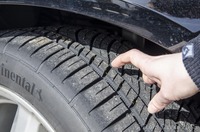
|
Our final, and most fun testing occurred on a 1.07 mile Dry Handling
Course, AKA race track. We used 2015 MINI Cooper S’ and BMW
M235i’s for our giggles professionally enthusiastic testing. MINIs
are FWD cars and they understeered with either the old ExtremeContact DWS
or newer DWS06. However, the new DWS06 provided more grip everywhere and
had much improved turn-in. We attribute that, again, to the chamfered
blocks, better compound and tread design. With the BMWs, again fitted with
a familiar Bridgestone RE970 Pole Position AS versus the DWS06, notes say
“far more lateral grip with DWS06, more accurate and a telegraphed
turn in, more precision from the steering, far less sliding at the front
and rear.” We felt, overall, less block squirm.
Having recently tested many new tires, both all season and winter, the
grip, handling, ride comfort, and longevity of tires amazes us. These are
not the super-premium, good-for-one-hot-lap tires, but affordable tires for
families on a budget and those who can’t afford track, street, wet,
and winter tire sets. Keep your family and self safe, keep good tires under
your car.


